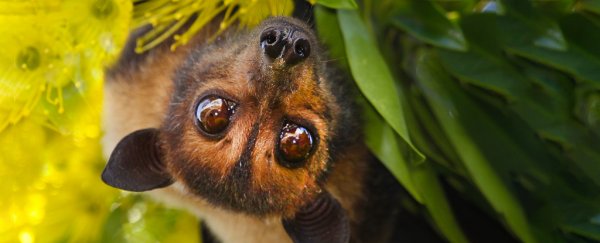Our collective pandemic experience has made us keenly aware that bats have an uncanny ability to carry around deadly viruses, but somehow still survive.
There is a lot we don't yet know about this enviable virus resistance - along with other bat abilities, such as extreme longevity - but new highly-detailed genome sequences may provide some clues.
"Thanks to a series of sophisticated statistical analyses… we have started to uncover the genetics behind bats' 'superpowers,' including their strong apparent abilities to tolerate and overcome RNA viruses," said Stony Brook University evolutionary and conservation biologist Liliana Dávalos.
By comparing the genomes of six bat species with other mammal genomes, the researchers have found evidence that the immune systems of bats functions in a unique way to other mammals. And better understanding exactly how they fight off viruses could help us do the same.
These virus resisting superpowers have allowed bats to thrive in many environments around the world. They now make up 20 percent of all living mammal species, with over 1,400 identified bat species.
And despite their ability to carry germs, they play vital roles in our ecosystems. At least 500 plant species depend on bat pollination (like bananas, mangos, and agave), other plants depend on their poop, and some species keep insects in check (including pesky mosquitoes) by devouring them.
Understanding their resistance and its unfortunate virus-incubating side effect, could help us co-exist more safely.
Dávalos and colleagues sequenced and compared the genomes of six very different bat species: insectivorous Rhinolophus ferrumequinum, Molossus molossus, Pipistrellus kuhlii and Myotis myotis, frugivorous Rousettus aegyptiacus and omnivorous Phyllostomus discolor.
They then compared these with 42 other mammal genomes, allowing them to find the parts that differ in bats, and therefore identify the genetic instructions that code for unique bat traits.
As well as a strong evolution on hearing-related genes - likely connected to their incredible echolocation abilities - the team found bats have lost a family of mammalian genes involved in our immune system. These include some immune-stimulating inflammation genes associated with autoimmune diseases in humans.
Changes in another group of immunity genes called APOBEC were also seen. These genes have been lost, expanded or duplicated across different bat species. They create enzymes involved in blocking a virus's ability to insert its genes into their host genome - a critical part of the virus's ability to replicate.
"More and more, we find gene duplications and losses as important processes in the evolution of new features and functions across the Tree of Life," explained Dávalos.
Within the bat genome the team also found what we might think of as fossilsed viruses - old bits of virus genes that were inserted into the bat genome and then passed on through generations.
Humans have these fossil viruses too and they provide a record of viral infections through our evolutionary history, like a genetic memory.
The bat genome had a higher diversity of these virus fossils, and they revealed bats have survived viruses that were previously thought to only infect birds.
Taken together, these findings support growing evidence that bats can tolerate and survive viral infections better than most mammals, because their immune system works differently.
"Our reference-quality bat genomes provide the resources required to uncover and validate the genomic basis of adaptations of bats, and stimulate new avenues of research that are directly relevant to human health and disease," the researchers wrote in their paper.
Maybe bats can one day share their antivirus superpowers with us as well as their germs.
This research was published in Nature.
